16 November 2017
When regarding the paintings of Istanbul by western painters, Golden Horn has a distinctive place and value. This body of water that separates the Topkapı Palace and the Historical Peninsula, in which monumental edifices are located, from Galata, where westerners and foreign embassies dwell, is as though an interpenetrating boundary. Naturally, it is situated in the center of all cultural interplay it. When painting the Historical Peninsula, most of the time foreign artists work as they gaze from the other side of the Golden Horn. The delegation of ambassadors that will be received by the sultan is depicted as it heads towards the Golden Horn. With the Byzantine and Ottoman monuments in the horizon, the Historical Peninsula is discernable. Additional to its harbor and shipyard, Golden Horn’s bridge accompanied by its water vehicles is one of the best locations to observe the life in this town that is so seamlessly integrated with the sea.
We have prepared a selection for you from the sceneries found in the Suna and İnan Kıraç Foundation Orientalist Painting Collection!
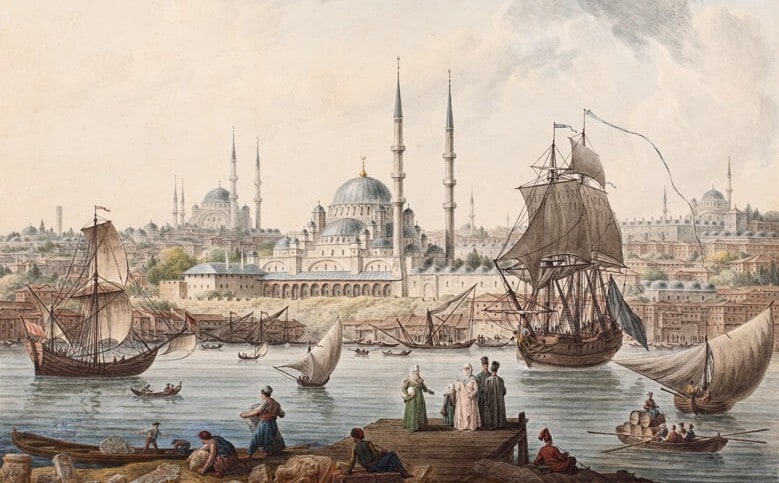
As one might conclude from the note the artist inscribed in the lower section of the painting, this work reveals the loading of the antiques collected by French Ambassador Choiseul-Gouffier on boat, to be shipped to France. Choiseul-Gouffier, who, together with Hilair, arrived in the Ottoman Empire for the first time in 1776 to map the Aegean, extensively used Hilair’s paintings in his book, Voyagé Pittoresque de la Gréce. This collaboration between artist and the diplomat, who had a penchant for Antiquity, persevered after Choiseul-Gouffier was appointed as ambassador to İstanbul in 1784.
In the lower left section of the painting, one can see the antiques being transported to caiques. Despite the fact that the painting is the depiction of a particular event, the view of the Port before the city silhouette defined by monumental buildings, as well as the routine of daily life also come to the fore. The views of the Golden Horn and the Port, which include local figures smoking pipes, chatting, waiting to embark the boat, are compositions that frequently appear in Hilair’s paintings of İstanbul.
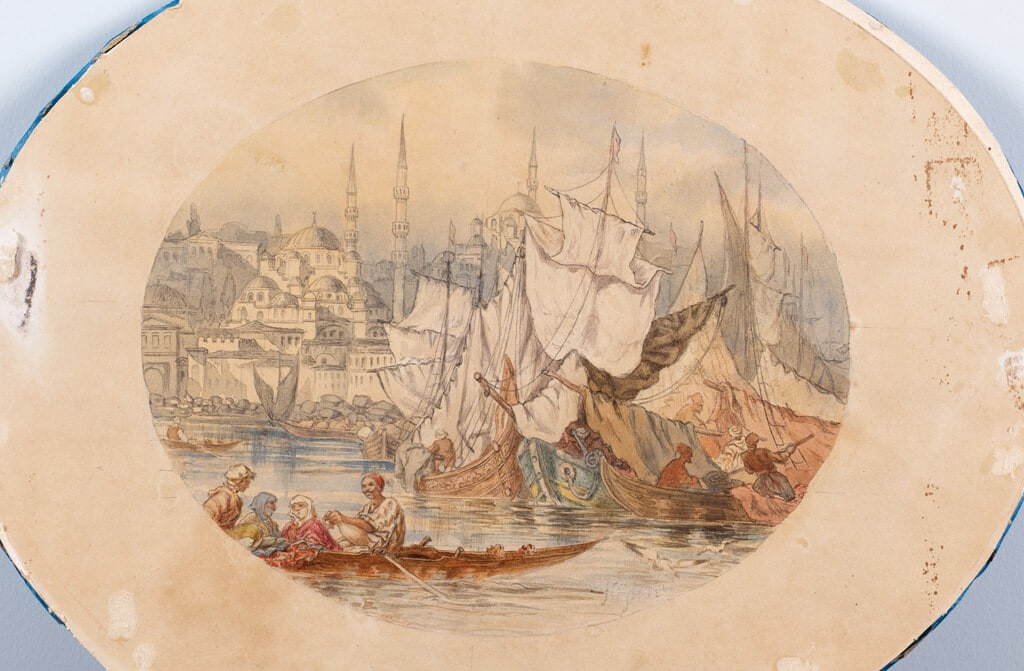
Preziosi spent two thirds of his life in İstanbul and knew the city intimately. His works, which were printed as lithographs in albums or periodicals such as The Illustrated London News in the second half of the 19th century, were important visual sources that reflect the İstanbul of period for Europeans. The artist’s studio in Beyoğlu was one of the most popular venues frequented by foreigners who wished to purchase a souvenir before they left İstanbul. Recognized as a watercolor painter and a lithograph artist, Preziosi lyrically conveys the commotion of the Golden Horn in this painting. The Ottoman women traveling in the piyades (light rowboats) in the foreground are juxtaposed against sailboats loaded with various commercial goods in the center, and the New Valide Mosque in the background.
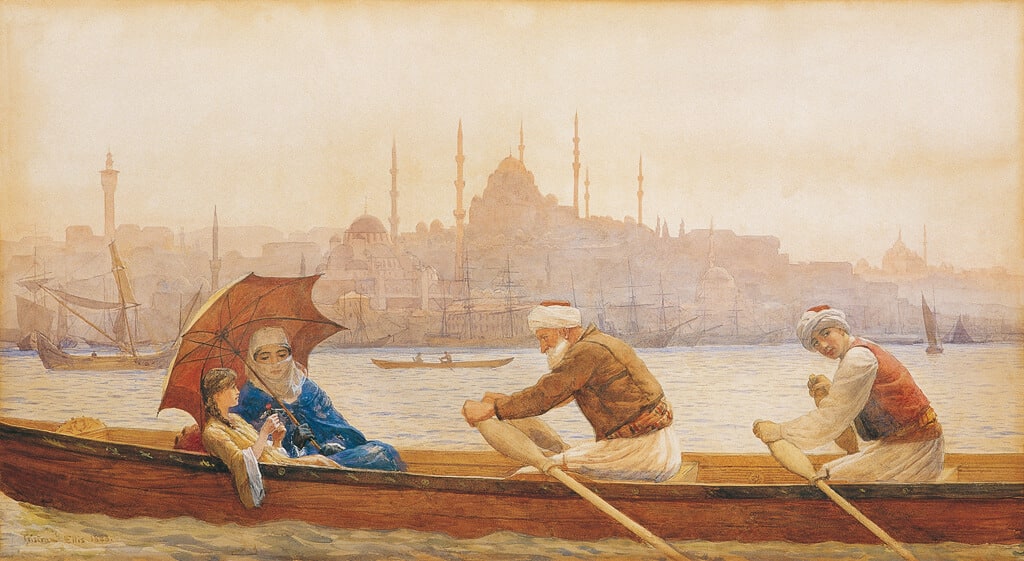
Renowned for his watercolor paintings revealing daily scenes of İstanbul busied with maritime traffic, against the backdrop of the city’s silhouette, Ellis portrays figures riding the light rowboats called piyade on the Golden horn in this work. This is one of Ellis’s two watercolor paintings about the Golden Horn featured in the exhibition. The background is dominated by the silhouette of the Historical Peninsula, comprised of Beyazıt Tower, as well as Süleymaniye and Rüstem Paşa Mosques.
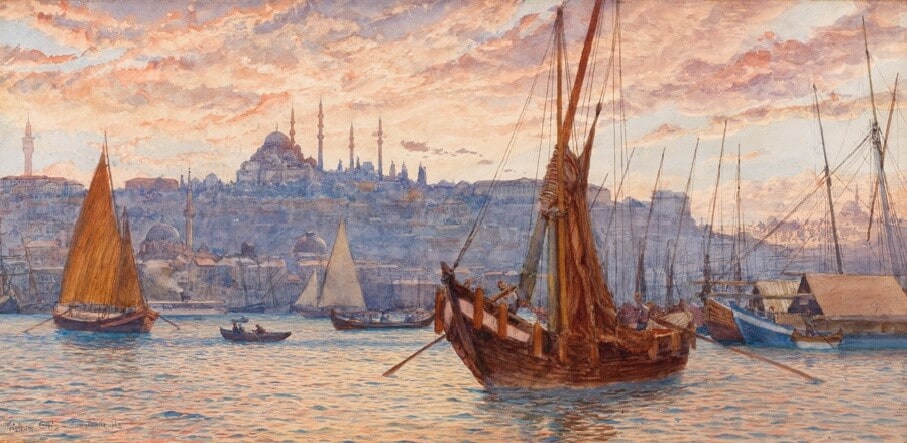
In this painting featuring the Golden Horn, the artist brings together the bustle of daily life on the sea with the silhouette of the city in the crimson light of the evening. The skyline of the Historical Peninsula in the background is defined by buildings such as the Süleymaniye Mosque, the Beyazıt Tower, and the Rüştem Paşa Mosque. This is one of the two of his paintings depicting life at the Golden Horn in the exhibition and employs a similar vantage point. While the painting bears the artist’s signature and the phrase “İstanbul”, it is not dated. Even though there is little information available about the artist, who is renowned for his watercolors, he is thought to have arrived in İstanbul after 1885.
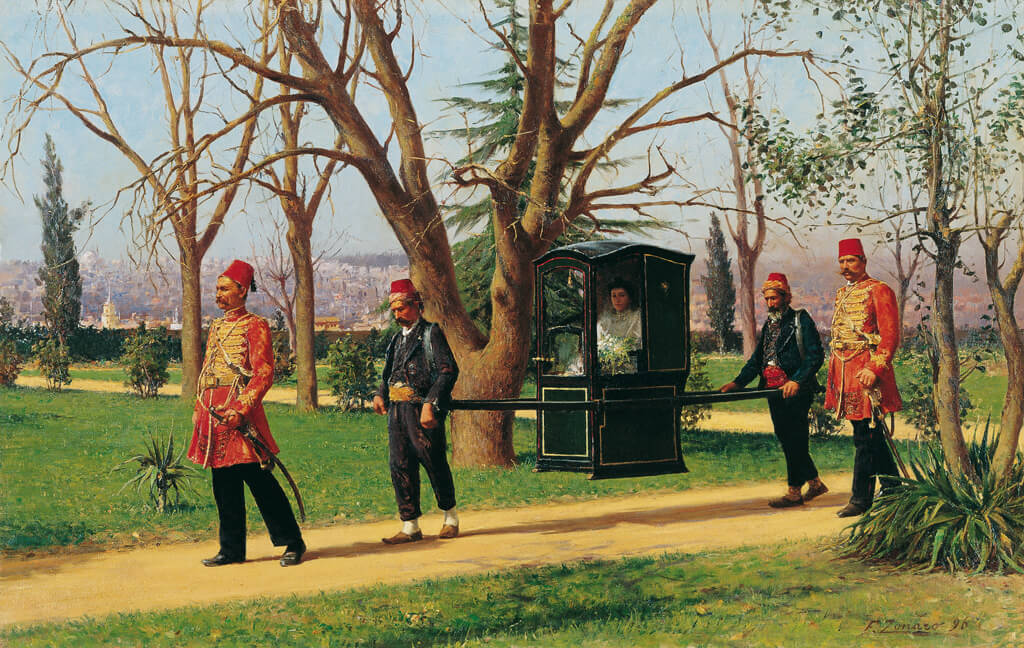
Until he was appointed as the court painter in 1896, Zonaro was predominantly commissioned by the European embassies in İstanbul. In his memoirs, the artist reveals that British Ambassador Sir Philip W. Currie (1894-96), who was one of Zonaro’s clients, commissioned a painting depicting his stepdaughter on the palanquin on her way to the church to marry to a diplomat. Sir Currie also requested the view of the Golden Horn -as seen from the garden of the embassy-, to be included in the background of the painting. The palanquin carriers, two embassy officials smartly dressed in their uniforms, and the young woman sitting on the palanquin in her bridal veil, posed for the artist for several days. According to the accounts kept by Zonaro’s wife Elisa, British Ambassador Sir Philip W. Currie paid 42.27 Liras in May 1896 in exchange for one oil painting and one watercolor painting. This must be the oil painting in question.
Tuesday - Saturday 10:00 - 19:00
Friday 10:00 - 22:00
Sunday 12:00 - 18:00
The museum is closed on Mondays.
On Wednesdays, the students can
visit the museum free of admission.
Full ticket: 300 TL
Discounted: 150 TL
Groups: 200 TL (minimum 10 people)